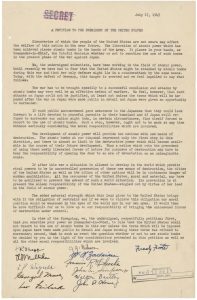In 1980, when I asked the press office at the U.S. Department of Energy to send me a listing of nuclear bomb test explosions, the agency mailed me an official booklet with the title “Announced United States Nuclear Tests, July 1945 Through December 1979.” As you’d expect, the Trinity test in New Mexico was at the top of the list. Second on the list was Hiroshima. Third was Nagasaki.
So, 35 years after the atomic bombings of those Japanese cities in August 1945, the Energy Department – the agency in charge of nuclear weaponry – was categorizing them as “tests.”
Later on, the classification changed, apparently in an effort to avert a potential P.R. problem. By 1994, a new edition of the same document explained that the bombings of Hiroshima and Nagasaki “were not ‘tests’ in the sense that they were conducted to prove that the weapon would work as designed . . . or to advance weapon design, to determine weapons effects, or to verify weapon safety.”
But the atomic bombings of Hiroshima and Nagasaki actually were tests, in more ways than one.
Take it from the Manhattan Project’s director, Gen. Leslie Groves, who recalled: “To enable us to assess accurately the effects of the bomb, the targets should not have been previously damaged by air raids. It was also desirable that the first target be of such size that the damage would be confined within it, so that we could more definitely determine the power of the bomb.”
A physicist with the Manhattan Project, David H. Frisch, remembered that U.S. military strategists were eager “to use the bomb first where its effects would not only be politically effective but also technically measurable.”
For good measure, after the Trinity bomb test in the New Mexico desert used plutonium as its fission source on July 16, 1945, in early August the military was able to test both a uranium-fueled bomb on Hiroshima and a second plutonium bomb on Nagasaki to gauge their effects on big cities.
Public discussion of the nuclear era began when President Harry Truman issued a statement that announced the atomic bombing of Hiroshima – which he described only as “an important Japanese Army base.” It was a flagrant lie. A leading researcher of the atomic bombings of Japan, journalist Greg Mitchell, has pointed out: “Hiroshima was not an ‘army base’ but a city of 350,000. It did contain one important military headquarters, but the bomb had been aimed at the very center of a city – and far from its industrial area.”

Oh … god … don’t let me start with this heinous crime against humanity …
Indeed … they were tests … a “Heinous Crime” … a “Crime Against Humanity” … for which we should remember that “H Truman” … is a “Criminal” and a “Terrorist” …
Seven of the United States’ eight five-star Army and Navy officers in 1945 agreed with the Navy’s vitriolic assessment. Generals Dwight Eisenhower, Douglas MacArthur and Henry ‘Hap’ Arnold and Admirals William Leahy, Chester Nimitz, Ernest King, and William Halsey are on record stating that the atomic bombs were either militarily unnecessary, morally reprehensible, or both.
On 17 July 1945, Manhattan Project scientist Leo Szilard wrote a petition to U.S. President Harry S. Truman—signed by 70 Manhattan Project scientists—asking him to refrain from using atomic weapons in the war.
It has long been considered a rule of warfare that armies fight armies in war. They don’t target non-combatants. The intentional killing of non-combatants is considered a war crime.
A good example of this principle involved the case of Lt. William Calley in the Vietnam War. Calley and his men shot and killed numerous non-combatants in a South Vietnamese village. The victims included women and children.
The U.S military prosecuted Calley as a war criminal — and rightly so. While the deaths of non-combatants oftentimes occur incidentally to wartime operations, it is a … “War Crime” … to … “Specifically Target Them for Death” …
In fact, scientists wrote a letter to Truman begging him to “NOT” use the a-bomb on cities or people … but Truman went ahead with the … “Massacres” …
